Creating a garden in your backyard is a rewarding and enjoyable project that can transform your outdoor space into a beautiful and functional oasis. Whether you want to grow fresh produce, beautiful flowers, or a combination of both, a backyard garden can provide you with a relaxing and therapeutic activity that also benefits the environment.
Key Takeaways:
- Choose plants that are adapted to your climate, soil, and sunlight conditions.
- Ensure your garden spot receives at least 6-8 hours of full sun per day and has access to a water source.
- Remove weeds and sod, have a soil test done, and add organic matter to improve soil quality.
- Loosen and prepare planting beds, plant according to seed instructions, and water at the right time.
- Starting a backyard garden can provide you with fresh produce, beautiful flowers, and a relaxing outdoor activity.
Consider What to Plant
Before diving into the garden design process, take some time to consider what you want to plant in your backyard space. If you’re new to gardening, start small and choose vegetables and herbs that your family will enjoy. This will make the process much more enjoyable and rewarding.
If you’re looking to create a backyard oasis with flowers, consider the difference between annuals and perennials. Annuals are plants that bloom for one season and will need to be replanted each year. Perennials, on the other hand, will come back year after year with proper care and maintenance. Keep in mind that perennials may require more attention to pruning, deadheading, and dividing.
It’s important to take into account the amount of sunlight your garden spot receives and choose plants accordingly. Some plants, like tomatoes and peppers, need a lot of sunlight to grow properly, while others like lettuce and spinach can thrive in partial shade. This will help ensure your plants are healthy and produce the best possible yield.
By considering what you want to plant and the specific growing conditions of your backyard, you’ll be able to create a beautiful and thriving garden that you can enjoy for years to come.
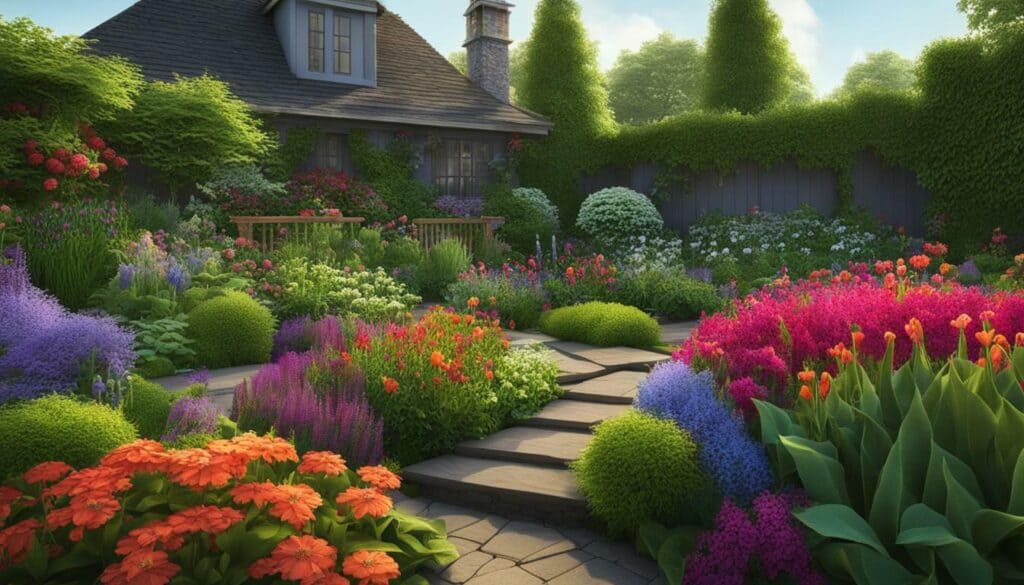
Pick the Best Garden Spot
The success of your backyard garden largely depends on choosing the right spot that receives ample sunlight and is easily accessible. Before deciding on a location, consider what you want to grow and whether it requires full sun or partial shade. Most plants need at least 6-8 hours of full sun, so take note of how much sunlight your yard gets throughout the day. If your yard is shady, consider planting herbs or vegetables that thrive in shade, such as lettuce or mint.
In addition to sunlight, it’s important to choose a relatively flat spot for your garden. Sloping gardens can be more difficult to deal with, and water may not be distributed evenly. Look for a level area that is not prone to flooding or standing water, and ensure that your garden has easy access to a water source. If you need to irrigate your garden, make sure the area has good drainage and water flow.
Before planting, clear the ground of weeds and sod. You can do this by cutting it out or using the lasagna gardening method, which involves layering cardboard, compost, and other materials. Lasagna gardening is a great option for gardening in small spaces or urban backyards, and it can improve soil quality while reducing the amount of work needed to prepare the ground.
Once you’ve cleared the ground, it’s important to test your soil to determine its nutrient levels and any necessary amendments. You can purchase a soil test kit or send a sample to a lab for analysis. Based on the results, you can adjust the pH level and add fertilizer or other amendments to improve soil quality.
Prepare your planting beds by loosening the soil and adding compost. This will help improve soil structure and provide the necessary nutrients for plant growth. You can also add mulch to help retain moisture and prevent weeds from growing.
When selecting plants, consider your climate, soil, and sunlight conditions. Choose plants that are suitable for your region and growing conditions, and pay attention to the amount of space they require. Some plants, such as tomatoes and cucumbers, need to be staked or trellised, while others, such as herbs, can be planted in containers.
Finally, start planting your chosen plants or seeds at the appropriate time, ensuring they receive the right amount of water. With a little bit of planning and preparation, you can create a beautiful and productive backyard garden that will provide fresh produce and a relaxing oasis.
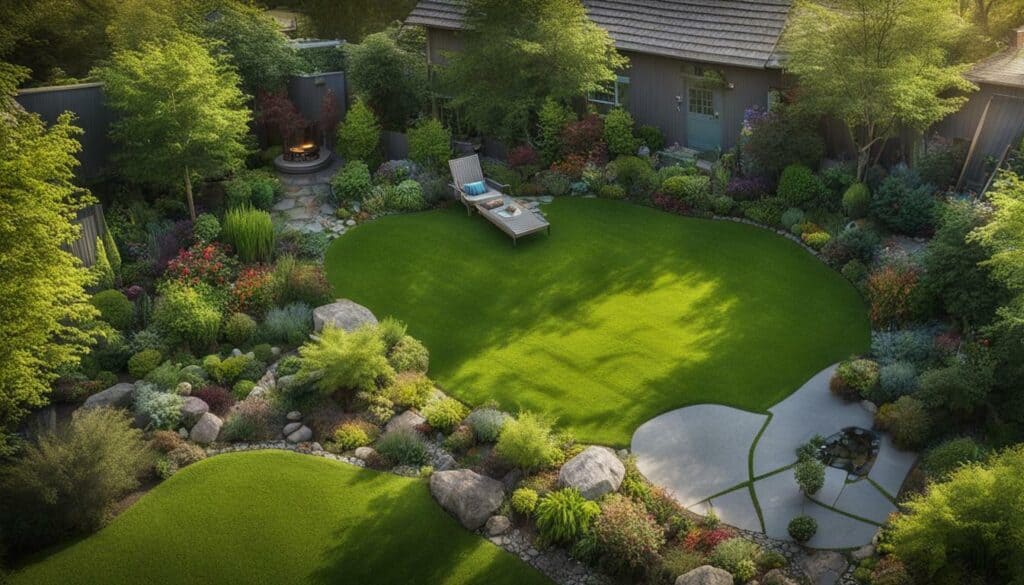
Pick the Best Garden Spot
Before you can start planting, it’s essential to clear the ground in your backyard and create a suitable space for your garden. If you’re gardening in small spaces or an urban backyard garden, it’s even more crucial to choose the right spot to make the most out of the limited area. The first step in creating your garden is to select an area that receives adequate sunlight and drainage.
Once you have an appropriate location, the next step is to remove all weeds and sod from the space. Clearing the ground can be done by using a spade to cut out the sod, but the lasagna gardening method is also a popular alternative. This method involves layering newspaper, compost, and mulch to smother grass and weeds, effectively creating a new layer of topsoil over the old one. The lasagna gardening method not only kills weeds but also improves the soil quality without the need for heavy machinery.
Testing and improving the soil is also essential for a successful backyard vegetable garden. A simple soil test done through a county cooperative extension office can determine nutrient levels and identify necessary amendments. Once you have cleared the ground and improved the soil, it’s time to prepare the planting beds. This involves loosening the soil by tilling or digging and incorporating organic matter, such as compost or manure.
When preparing the planting beds, consider the type of plants you want to grow based on your preferences and gardening zone. Beginners can start with easy-to-grow plants like vegetables, annuals, and perennials. It’s also crucial to consider the proper timing when starting your garden, either sowing seeds directly or transplanting seedlings. After planting, watering the garden at the right time and providing proper care will ensure its success. Remember, clearing the ground is the first step in creating a thriving vegetable garden.

Test and Improve Your Soil
A crucial step in creating a thriving garden is to test and improve the quality of your soil in the backyard. For a backyard vegetable garden, this is especially important. To test your soil, contact your county cooperative extension office for a soil test. The test results will inform you of the soil’s pH and nutrient levels. Based on the results, you can determine which soil amendments to add to your soil to optimize plant growth.
If you’re gardening in small spaces, such as a balcony or patio, consider using raised garden beds filled with a high-quality soil mix. This will allow you to control the soil’s composition and give your plants the best chance to thrive.
Adding organic matter like compost to your soil is an excellent way to improve soil quality. Compost helps with drainage and soil structure and provides your plants with necessary nutrients. Spread a layer of organic matter over the soil and work it in to improve your soil’s condition.
It’s also essential to regularly maintain your soil by adding more organic matter and testing it periodically to ensure it’s still healthy and balanced. This is especially crucial in a backyard garden because the soil can become depleted over time.
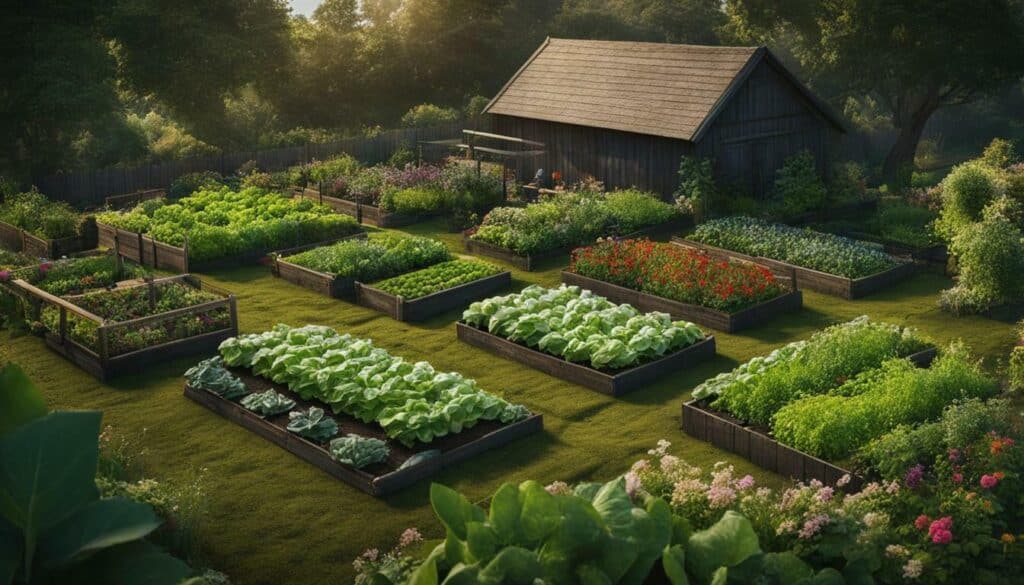
Gardening in small spaces can be challenging, but with the right soil mix and proper care, you can create a thriving garden in your backyard. By testing and improving your soil, you can ensure that your plants will grow healthy and strong, providing you with a bountiful harvest.
Prepare Your Planting Beds
Once you have cleared the ground and improved the soil, it’s time to prepare the planting beds for your backyard garden. This involves creating a hospitable environment for your plants to grow and thrive.
First, consider what you want to plant in your backyard garden. Are you looking to grow vegetables, herbs, flowers or a combination of all three? Knowing what you want to grow will help you determine the size and layout of your planting beds.
Next, choose a location that receives at least 6-8 hours of full sun per day and has easy access to water. Once you have selected the perfect spot for your planting beds, it’s time to clear the ground of weeds and sod. You can either cut it out or use the lasagna gardening method, which involves layering organic matter directly on top of grass or weeds to create a new garden bed.
Test your soil for its nutrient levels and amend it with organic matter if needed. Loosen the soil in your planting beds before sowing or planting to help roots grow easily. Adding a layer of compost or aged manure to your soil will help improve its texture and add nutrients.
Pick the right plants for your backyard garden. Consider your climate, soil, and sunlight conditions. Certain plants like tomatoes and peppers require full sun, while others like lettuce and spinach thrive in partial shade.
Start planting by sowing seeds directly in the garden or transplanting young plants. It’s important to space your plants correctly to ensure they have enough room to grow. Follow the planting instructions on the label of each seed packet or transplant container.
Finally, water your plants at the right time and provide proper care for your backyard garden. Water in the morning or evening when temperatures are cooler and the sun is not as strong. Avoid getting water on the leaves, as this can lead to disease. Provide support for tall plants like tomatoes and stake them early to prevent them from falling over.
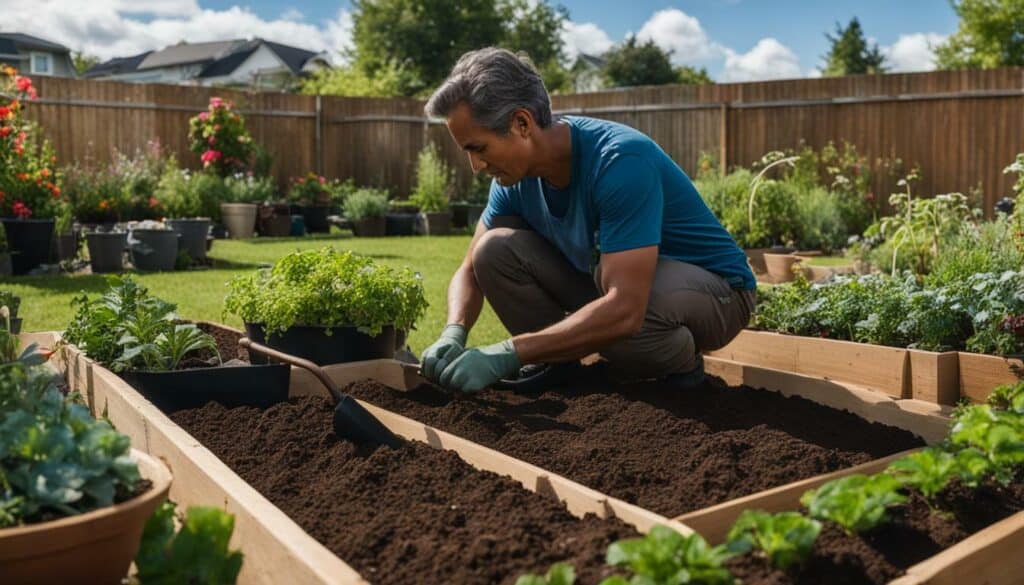
With these gardening tips for the backyard, you can create a beautiful and thriving garden in no time!
Pick Your Plants
The plant selection is a critical step in creating a thriving backyard garden, so take some time to choose plants that will thrive in your specific backyard environment. Consider what you want to plant – vegetables, herbs, or flowers – and choose plants that your family will enjoy. If you’re looking for showy annuals that bloom throughout the summer, petunias, marigolds, and zinnias are great choices. For perennials that come back year after year, plant peonies, irises, or daylilies.
When selecting plants, pay attention to their light requirements. Most vegetables need at least 6-8 hours of full sun per day, so choose a garden spot that receives plenty of sunlight. If you’re planting a flower garden, consider the sunlight requirements of the specific plants you choose. For example, roses require full sun, while impatiens prefer partial shade.
Before planting, clear the ground of weeds and sod. You can either cut it out or use the lasagna gardening method, which involves layering organic materials like leaves, grass clippings, and compost to create a rich, nutrient-dense soil bed.
Once your soil is in good shape, test it to determine its nutrient levels and amend it accordingly with organic matter. You can also adjust the pH level of your soil with lime or sulfur to ensure it’s optimal for the plants you want to grow.
Prepare your planting beds by loosening the soil and mixing in the organic matter. Make sure the soil is level and free of any large rocks or debris that could interfere with plant growth.
When choosing your plants, tailor your choices to your climate, soil, and sunlight conditions. Local nurseries and garden centers are great resources for finding plants that will thrive in your specific area. Consider starting from seed or buying starts, depending on your preferences and experience level.
Plant at the right time, following the instructions on the seed packet or plant tag. Remember to water your plants at the right time and take care of your garden by providing proper maintenance. With a little planning and effort, your backyard garden will be blooming in no time and will provide you with a beautiful oasis to enjoy.

Start Planting
Now that you have selected your plants, it’s time to start the exciting process of planting them in your backyard garden. Whether you are starting a backyard vegetable garden or a flower garden, the steps are similar.
First, prepare the soil by tilling it when it’s moist and adding organic matter to improve its structure and fertility. If you are gardening in small spaces, you can use container gardening or raised beds to maximize your growing area.
When planting your seeds or transplants, make sure to space them properly according to the recommended spacings on the seed packet or plant tag. For small spaces, consider using companion planting techniques to get the most out of your space and ensure that your plants thrive.
After planting, water your plants at the right time. In hot weather, water in the morning or evening to reduce evaporation and prevent leaf scorch. In cooler weather, water less frequently but deeply to encourage deeper root growth.
Finally, protect your plants from pests by using organic pest control methods such as companion planting, handpicking, and using natural repellents. With these tips, you can start planting your backyard vegetable garden or flower garden and enjoy the fruits of your labor.
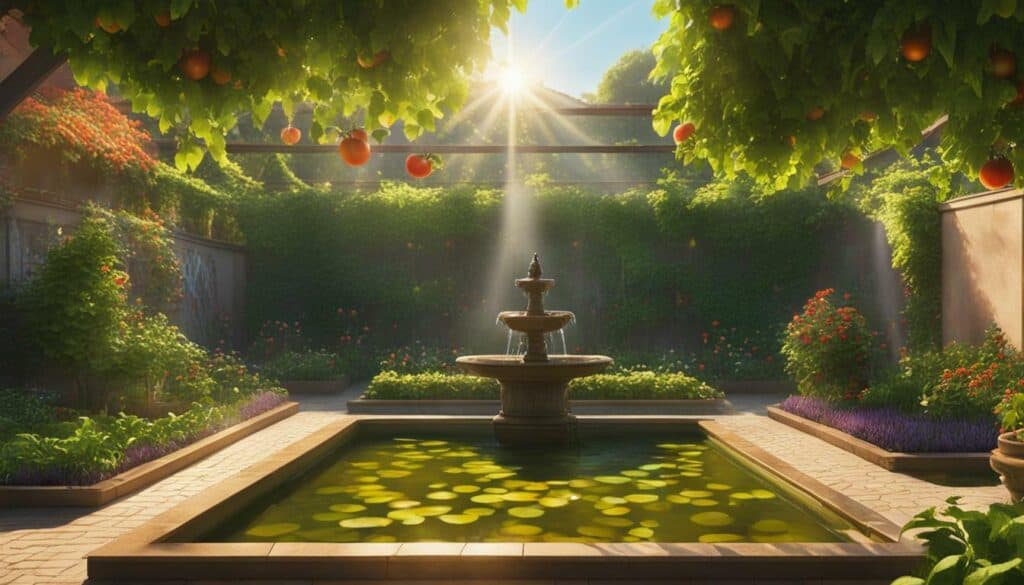
Pro tip: Consider using a soaker hose or drip irrigation to water your plants more efficiently and prevent moisture-related diseases in your garden.
Water at the Right Time
Providing adequate water is essential for the success of your backyard garden, and knowing when and how to water is crucial. The best time to water your plants is in the morning, before the sun is high in the sky and temperatures rise. This allows the soil to absorb the water and for the plants to use it throughout the day. Watering in the evening can lead to excess moisture on the leaves, which can lead to disease and fungus.
It is important to consider factors such as the climate, soil moisture, and sunlight when determining the watering schedule for your garden. In general, most plants require at least 1 inch of water per week, either from rainfall or irrigation. However, this can vary depending on the climate and soil conditions, so it is important to pay attention to your plants and adjust your watering schedule accordingly.
Another important factor to consider is the type of soil in your garden. If the soil is heavy and clay-like, it may require less frequent watering, as it retains moisture for longer periods of time. However, if the soil is sandy or loamy, it may require more frequent watering, as it does not retain moisture as well.
A good way to monitor soil moisture is to stick your finger into the soil about 2 inches deep. If it feels dry, it is time to water. If it feels moist, it is best to wait a day or two before watering again.
By following these backyard gardening tips for beginners, you can ensure that your garden thrives and produces a bountiful harvest. Establishing a regular watering schedule and monitoring soil moisture can help your plants grow strong and healthy.
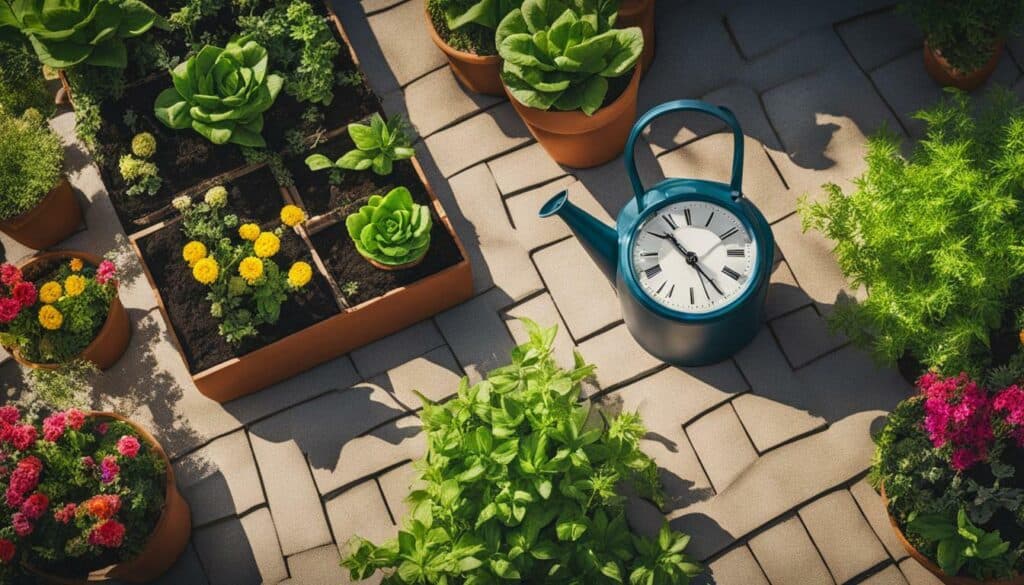
“Watering is the key to successful gardening. Without adequate moisture, plants cannot grow and thrive. By providing the right amount of water at the right time, you can ensure the success of your backyard garden.”
Pick Your Plants
After preparing your planting beds, it’s time to choose the right plants for your backyard garden. Consider your climate, soil, and sunlight conditions when deciding on which plants to grow.
If you’re a beginner, start with easy-to-grow plants such as tomatoes, cucumbers, or herbs like basil and rosemary. For a beautiful flower garden, choose plants that thrive in your local environment such as marigolds, zinnias, or petunias.
Creating a backyard garden design can also be a fun and creative process. Consider incorporating different colors, textures, and heights into your garden to add visual interest. You can even mix flowers and vegetables together for a unique twist.

When selecting plants, pay attention to the growing instructions on the package or plant tag. Some plants require more water than others, while some prefer more shade or sun. Keep in mind the space each plant needs to grow and plan accordingly.
Once you have chosen your plants, it’s time to get planting. Whether you’re sowing seeds directly into the garden or transplanting young plants, be sure to follow the instructions on the package or tag for optimal growth.
By carefully selecting the right plants for your backyard garden design, you can create a beautiful and thriving space that you can enjoy for years to come.
Harvest and Enjoy
As your backyard garden begins to flourish, the time will come to harvest the fruits, vegetables, and herbs you have diligently grown. There’s nothing quite like the satisfaction of eating something you’ve grown yourself. Here are a few tips to help you make the most of your harvest.
Know When to Harvest
One of the most important things to know when it comes to harvesting is when to do it. Vegetables like tomatoes and peppers should be picked when they are fully ripe, while leafy greens like lettuce and kale can be harvested when they are young and tender. Herbs should be cut before they flower for the best flavor.
Harvest Gently
When it comes to harvesting, it’s important to be gentle with your plants. Use a sharp pair of scissors or pruning shears to cut fruits and vegetables from their stems so you don’t damage the plant. Be careful not to pull too hard on the plant, as this can cause damage and make it more susceptible to disease.
Enjoy the Fruits of Your Labor
Once you’ve harvested your produce, it’s time to enjoy it. Whether you’re cooking up a fresh tomato sauce or making a salad with your homegrown greens, savor the flavor of your hard work. Share your bounty with friends and family, or preserve your harvest by canning or freezing it for later use. Your backyard garden can provide you with fresh, healthy food all season long, so don’t be afraid to experiment in the kitchen!

By following these tips, you’ll be able to enjoy your backyard garden to the fullest. Harvesting your own fresh, organic produce is a wonderful feeling that you won’t want to miss. So roll up your sleeves, grab your gardening tools, and get ready to enjoy the fruits of your labor!
Conclusion
Creating a garden in your backyard is a wonderful way to enhance your outdoor space, connect with nature, and enjoy the fruits of your own labor. With the right planning and care, your backyard oasis can provide you with fresh produce and a tranquil retreat.
Consider incorporating backyard landscaping ideas and designing your garden to fit your personal style and taste. Installing a fence can provide privacy and extra protection for your plants. Remember to start small and choose plants that are suitable for your specific climate, soil, and sunlight conditions.
Clearing the ground and preparing the soil will ensure healthy growth and fruitful yields. Providing adequate water, mulching, and fertilizing will help maintain your garden’s health and vitality. Caring for your garden is an ongoing process, but the rewards are priceless.
So why not get started on creating your own backyard garden? With the tips and guidelines provided in this article, you can create a backyard oasis that you and your family can enjoy for years to come.
FAQ
Q: What should I consider when deciding what to plant in my backyard garden?
A: It’s important to decide if you want a vegetable, herb, or flower garden. Choose plants that your family will eat or be willing to try. Start small until you know what you’re getting into.
Q: How do I pick the best garden spot in my backyard?
A: Choose a location that receives 6-8 hours of full sun each day. Observe your yard to determine the areas with full sun versus partial or full shade. Ensure easy access to a water source.
Q: How do I clear the ground for my backyard garden?
A: Remove weeds and sod in the area you plan to plant. Use a spade to cut out sod sections for quick results. Use the lasagna gardening method by layering newspaper and compost for a longer-term project.
Q: How can I test and improve the soil in my backyard garden?
A: Have a soil test done through your county cooperative extension office. Add organic matter like compost to improve drainage and nutrient content. Mix the organic matter into the soil by gently turning the top 6-8 inches.
Q: What should I do to prepare my planting beds?
A: Loosen the soil by tilling with a mechanical device or digging by hand. Work the soil when it’s moist enough to form a loose ball but dry enough to fall apart. Mix in the organic matter while digging or tilling.
Q: How do I choose the right plants for my backyard garden?
A: Choose plants adapted to your climate, soil, and sunlight conditions. Consider easy-to-grow plants like annuals (calendula, cosmos, zinnias), perennials (black-eyed susans, daylilies, phlox), and vegetables (cucumbers, lettuce, peppers, tomatoes).
Q: What’s the best time to start planting in my backyard garden?
A: Plant cold-tolerant plants like pansies and kale in autumn or late winter. Wait until the danger of frost has passed to plant warm-weather plants like tomatoes. Start seeds indoors a few weeks before the last frost date or buy young plants to transplant.
Q: When should I water my backyard garden?
A: Water plants when they need it, usually in early morning or late afternoon. Avoid watering during the hottest part of the day to prevent evaporation. Keep seeds and seedlings moist but not wet to prevent rot.
Q: How do I maintain my backyard garden?
A: Regularly weed the garden to prevent competition for nutrients and water. Monitor for pests and diseases and take appropriate action. Provide support for tall plants and prune as needed for optimal growth.
Q: When and how should I harvest my backyard garden produce?
A: Harvest vegetables and herbs when they reach the desired size or ripeness. Use sharp tools to avoid damaging the plant. Enjoy the fruits of your labor by incorporating fresh produce into your meals or sharing with others.
What Are the Simple and Easy Steps to Gardening Vegetables in My Backyard?
If you’re wondering how to start gardening vegetables in your backyard, the process can be made simple with a few easy steps. First, choose a suitable spot with ample sunlight. Prepare the soil by removing debris and adding compost or organic matter. Next, select vegetable varieties that thrive in your climate. Plant the seeds or seedlings according to the instructions. Finally, water regularly, control weeds, and monitor for pests. Gardening vegetables made simple can bring fresh and nutritious produce to your table right from your backyard.
Source Links
- https://growitbuildit.com/how-to-start-a-vegetable-garden-in-your-backyard/
- https://www.bhg.com/gardening/yard/garden-care/ten-steps-to-beginning-a-garden/
- https://www.wikihow.com/Start-a-Garden
- https://www.npr.org/2020/04/17/837300800/this-is-a-good-time-to-start-a-garden-heres-how
- https://frugalfamilyhome.com/home/gardening/how-to-start-a-vegetable-garden-from-scratch
- https://www.thespruce.com/how-to-start-a-garden-from-scratch-2132778
- https://www.gardensthatmatter.com/choose-garden-location/
- https://www.almanac.com/where-put-vegetable-garden
- https://bonnieplants.com/blogs/garden-fundamentals/how-to-plant-an-in-ground-garden-its-easy
- https://www.almanac.com/content/3-simple-diy-soil-tests
- https://extension.oregonstate.edu/gardening/soil-compost/how-do-i-test-my-garden-soil
- https://www.almanac.com/soil-preparation-how-do-you-prepare-garden-soil-planting
- https://www.creativevegetablegardener.com/prepping-spring-garden-beds/
- https://getbusygardening.com/prepare-vegetable-garden-for-planting/
- https://awaytogarden.com/soil-preparation-7-ways-to-make-a-garden-bed/
- https://www.thefrugalfarmgirl.com/create-vegetable-garden-backyard/
- https://www.almanac.com/when-water-your-vegetable-garden-watering-chart
- https://www.hgtv.com/outdoors/gardens/planting-and-maintenance/the-proper-way-to-water-your-garden
- https://www.wikihow.com/Choose-the-Best-Time-for-Watering-a-Garden
- https://food52.com/blog/27431-how-to-maintain-a-vegetable-garden
- https://www.gardenersworld.com/how-to/grow-plants/gardening-for-beginners-how-to-care-for-your-garden/
- https://savvygardening.com/patio-vegetable-garden/
- https://growingourown.wordpress.com/6-conclusion/
- https://www.agrifarming.in/how-to-start-a-backyard-garden-from-scratch-a-step-by-step-guide-for-beginners

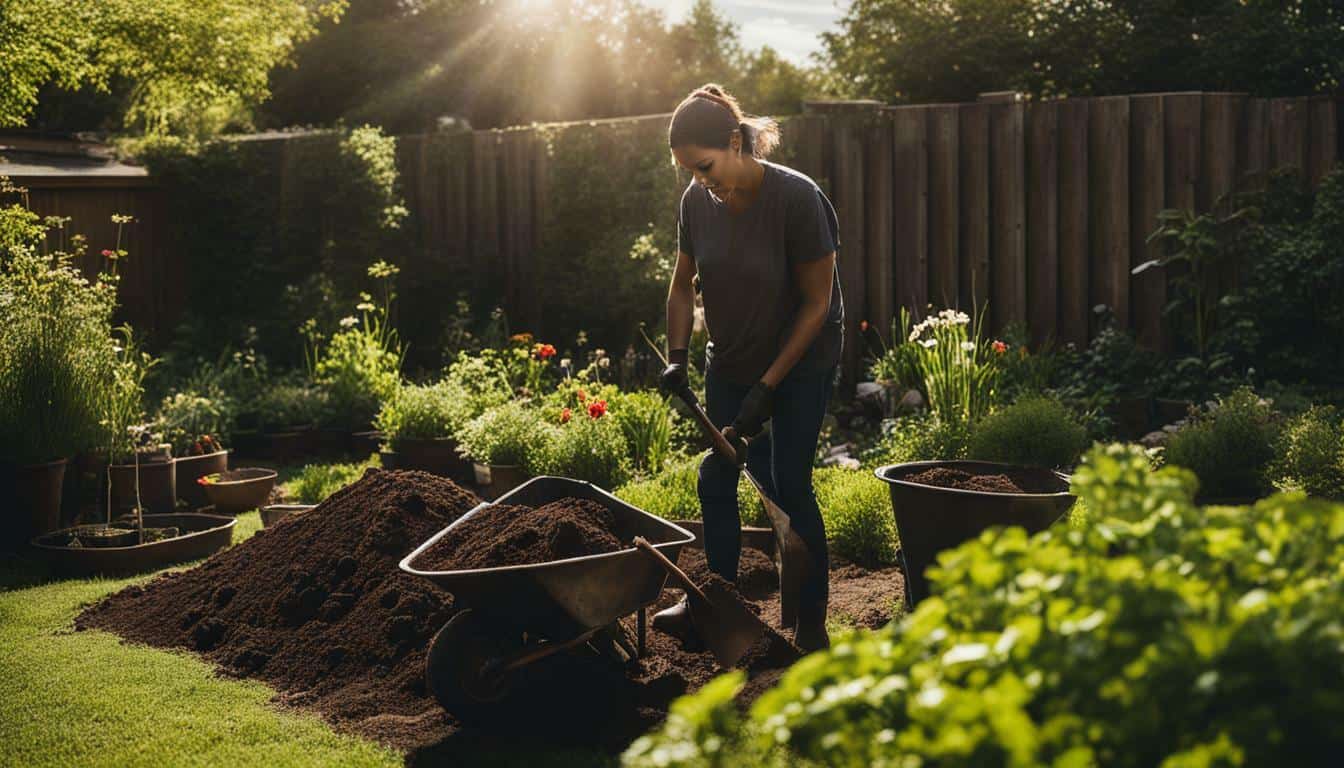



Leave a Reply